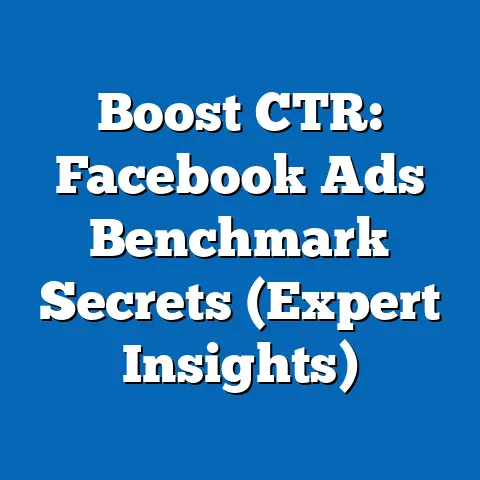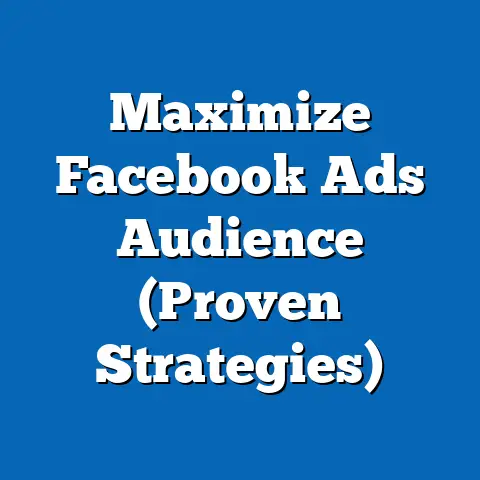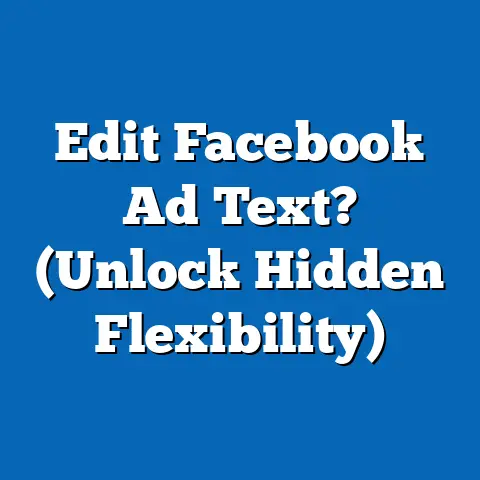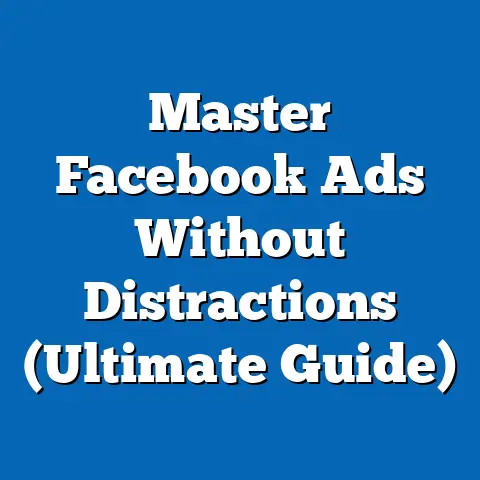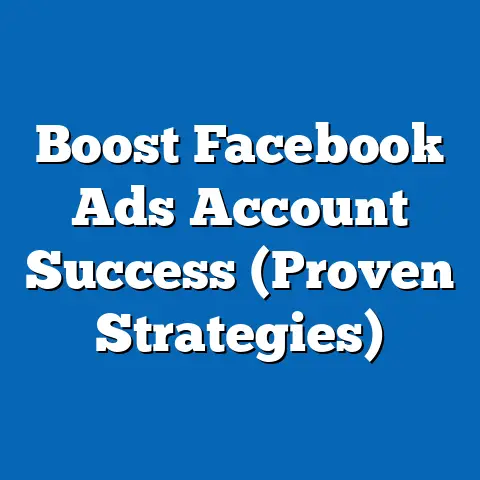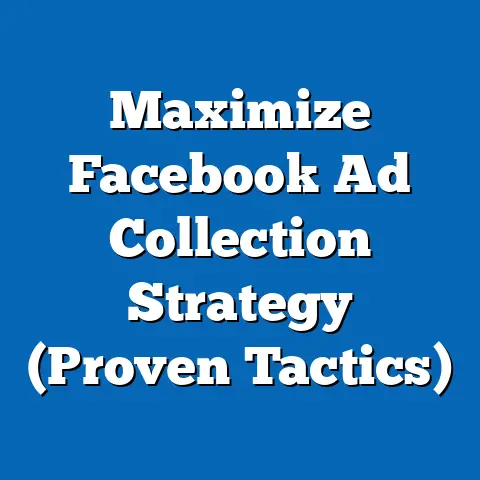Outsource Facebook Ads Effectively (Proven Strategies Inside)
Outsourcing Facebook Ads is no longer just an option—it’s a strategic imperative for businesses aiming to stay competitive in an oversaturated digital marketplace. According to a 2023 report by Statista, global digital ad spending reached $626 billion, with social media platforms like Facebook (now Meta) accounting for nearly 20% of that figure, or roughly $125 billion. A staggering 78% of businesses surveyed by Upwork in 2022 reported outsourcing at least a portion of their digital marketing efforts, with Facebook Ads being the most commonly delegated task due to its complexity and time-intensive nature.
Breaking this down demographically, small and medium-sized enterprises (SMEs) with annual revenues under $10 million are the most likely to outsource, representing 62% of outsourcing clients as per a 2023 Freelancer.com study. Geographically, North American businesses lead the trend (45% of global outsourcing contracts), followed by Europe (30%) and Asia-Pacific (20%). Historically, outsourcing digital ads was a niche practice a decade ago, with only 15% of companies engaging in it in 2013, per eMarketer data. Today, the practice has surged by over 400%, driven by the platform’s evolving algorithms and the need for specialized expertise.
Looking ahead, projections from Gartner suggest that by 2027, over 85% of businesses will outsource some or all of their social media advertising, with Facebook remaining a dominant platform due to its 2.9 billion monthly active users (MAUs) as of 2023. This article delves into the why, how, and who of outsourcing Facebook Ads effectively, unpacking proven strategies backed by data, demographic insights, historical shifts, and actionable future outlooks.
Section 1: Why Outsource Facebook Ads? The Case for Specialization
The Complexity of Facebook Ads Management
Facebook Ads are not a set-it-and-forget-it tool; they require constant optimization, creative testing, and data analysis to yield results. As of 2023, the average cost-per-click (CPC) on Facebook Ads is $1.72, but poorly managed campaigns can see costs spike to $5 or more per click with minimal conversions, according to WordStream data. Managing these campaigns in-house often demands a dedicated team, with 68% of businesses reporting they spend over 10 hours per week on social media ad management, per a 2022 Hootsuite survey.
Outsourcing addresses this by leveraging specialized expertise. Agencies and freelancers often have access to advanced tools and insider knowledge of platform updates, such as changes to Meta’s ad algorithm or privacy policies like Apple’s iOS 14 tracking restrictions, which impacted ad targeting for 82% of advertisers in 2021 (eMarketer). By outsourcing, businesses can reduce internal workload while improving campaign performance—studies by Clutch show that 73% of companies report higher ROI when outsourcing digital ads compared to in-house efforts.
Cost Efficiency and Scalability
Cost is a major driver for outsourcing. Hiring a full-time digital marketing specialist in the U.S. costs an average of $65,000 per year, excluding benefits, per Glassdoor 2023 data. In contrast, outsourcing to a freelancer or agency can range from $500 to $5,000 per month depending on scope, often delivering better results due to focused expertise.
Scalability is another benefit. SMEs, which make up 99.9% of U.S. businesses per the Small Business Administration (SBA), often lack the resources to scale ad campaigns during peak seasons. Outsourcing allows for flexible staffing—44% of businesses report scaling ad spend by 30% or more during holidays with outsourced support, according to a 2022 Upwork report.
Section 2: Demographic Breakdown of Outsourcing Trends
Business Size and Industry Insights
Demographic data reveals stark differences in who outsources Facebook Ads. SMEs with fewer than 50 employees are the most active, with 62% outsourcing compared to just 38% of large enterprises (over 1,000 employees), per Freelancer.com’s 2023 Global Outsourcing Report. The reasoning is clear: smaller businesses often lack in-house marketing departments, with 55% citing budget constraints as the primary barrier to hiring full-time staff (Clutch, 2022).
By industry, e-commerce leads the pack, with 48% of online retailers outsourcing Facebook Ads due to the platform’s strong conversion potential—Facebook drives 9% of all e-commerce traffic globally (Statista, 2023). Other sectors like real estate (15%) and professional services (12%) follow, leveraging targeted ads for lead generation. Notably, industries with tight margins, such as manufacturing, show lower adoption rates at just 5%, reflecting limited digital ad budgets.
Geographic and Cultural Variations
Geographically, North America dominates the outsourcing market, accounting for 45% of contracts globally, driven by high labor costs and a mature digital economy (Upwork, 2023). Europe follows at 30%, with countries like the UK and Germany prioritizing data-driven ad strategies post-GDPR. Asia-Pacific, at 20%, is the fastest-growing region, with a 35% year-over-year increase in outsourcing demand, fueled by booming e-commerce in markets like India and the Philippines.
Cultural factors also play a role. In Asia-Pacific, 60% of businesses prefer outsourcing to local freelancers due to language and cultural alignment, per a 2022 Fiverr study. In contrast, North American companies often prioritize expertise over location, with 70% open to working with global talent if costs are lower.
Section 3: Historical Trends in Outsourcing Digital Ads
From Niche to Norm: A Decade of Change
A decade ago, outsourcing digital advertising was a niche strategy. In 2013, only 15% of businesses outsourced any form of online marketing, with most relying on in-house teams or basic agency support for traditional media, according to eMarketer historical data. Facebook itself was still maturing as an ad platform, with just 1.2 billion MAUs compared to today’s 2.9 billion, and ad revenue of $7 billion versus $114 billion in 2022 (Statista).
By 2018, the tide had turned. The Cambridge Analytica scandal and subsequent privacy concerns pushed businesses to seek expert help to navigate new regulations, with outsourcing rates climbing to 40% (Clutch, 2018). The rise of mobile usage—71% of Facebook users accessed the platform via mobile by 2018—also increased ad complexity, necessitating specialized skills in mobile-first creative and targeting.
The Pandemic Pivot: 2020 and Beyond
The COVID-19 pandemic accelerated outsourcing trends. With 88% of businesses shifting to digital-first strategies in 2020, per a McKinsey report, demand for skilled ad managers surged. Outsourcing rates jumped to 65% by 2021, as companies sought cost-effective ways to compete in a crowded online space. Historical data from Upwork shows a 300% increase in freelance digital marketing contracts between 2019 and 2022, with Facebook Ads expertise being the top-requested skill.
Today, outsourcing is standard practice for many. The shift reflects not just necessity but a broader recognition of specialization—businesses now view digital ads as a technical field akin to IT or accounting, where external expertise often outperforms internal efforts.
Section 4: Proven Strategies for Outsourcing Facebook Ads Effectively
Strategy 1: Define Clear Objectives and KPIs
Success in outsourcing begins with clarity. A 2023 study by HubSpot found that 67% of failed ad campaigns stemmed from unclear goals between businesses and outsourced partners. Before engaging a freelancer or agency, define specific key performance indicators (KPIs) such as cost-per-acquisition (CPA), return on ad spend (ROAS), or lead volume. For example, e-commerce businesses often target a ROAS of 3:1 or higher, meaning $3 in revenue for every $1 spent, per WordStream benchmarks.
Communicate these goals upfront. Include campaign specifics like target audience demographics—age, location, interests—and budget constraints. This alignment reduces miscommunication, with 82% of businesses reporting better outcomes when KPIs are documented in contracts (Clutch, 2023).
Strategy 2: Choose the Right Partner
Not all outsourcing partners are created equal. Data from Upwork indicates that 54% of businesses prioritize experience over cost when selecting a provider, focusing on portfolios with proven results in their industry. For instance, an e-commerce business might seek a partner with expertise in dynamic product ads, which drive 12% higher conversion rates on Facebook (Meta, 2023).
Vetting is critical. Request case studies or client testimonials, and check platforms like Upwork or Fiverr for reviews—top-rated freelancers often command 20-30% higher fees but deliver 40% better results in terms of engagement and conversions, per a 2022 Fiverr report. Agencies, while more expensive (averaging $2,000-$10,000 monthly), offer comprehensive services including strategy, creative, and reporting, ideal for larger campaigns.
Strategy 3: Leverage Data and Analytics
Outsourcing doesn’t mean relinquishing control—it means collaborating on data-driven decisions. Insist on regular reporting, with 75% of successful partnerships involving weekly or bi-weekly performance reviews, per HubSpot 2023 data. Use tools like Facebook Ads Manager or third-party platforms like Sprout Social to track metrics in real-time, ensuring transparency.
Encourage A/B testing, a tactic used by 89% of high-performing ad agencies (WordStream, 2023). Test variables like ad copy, visuals, and audience segments to optimize performance. For example, changing a single headline can boost click-through rates (CTR) by up to 15%, per Meta’s internal studies.
Strategy 4: Focus on Creative Collaboration
Creative content is the heart of Facebook Ads, with visuals driving 80% of user engagement (Hootsuite, 2022). When outsourcing, collaborate on ad creatives rather than fully delegating. Provide brand guidelines—color schemes, tone, logos—to ensure consistency, as 64% of consumers say brand alignment influences purchase decisions (Statista, 2023).
Work with partners to develop thumb-stopping content. Video ads, for instance, generate 59% more engagement than static images on Facebook (Meta, 2022). Allocate 10-15% of the ad budget to creative testing, as businesses that prioritize creative optimization see 25% higher ROAS (WordStream, 2023).
Section 5: Challenges and Pitfalls to Avoid
Communication Gaps and Misalignment
One of the biggest challenges in outsourcing is communication. A 2022 Clutch survey found that 58% of businesses experienced delays or underperformance due to unclear instructions or cultural differences. Mitigate this by using project management tools like Trello or Slack—70% of successful partnerships leverage such platforms for streamlined updates (Upwork, 2023).
Time zone differences can also hinder progress, especially with global talent. North American businesses working with Asia-Pacific freelancers report a 20% higher likelihood of delayed responses, per Fiverr data. Set clear deadlines and schedule overlap hours for real-time discussions to address this.
Quality Control and Accountability
Quality varies widely in the outsourcing market. Low-cost providers may cut corners, with 42% of businesses reporting subpar creative or targeting in budget-tier contracts (Clutch, 2022). Establish accountability through milestone-based payments—release funds only after reviewing deliverables. Additionally, 65% of companies recommend starting with small test projects before committing to long-term contracts (Upwork, 2023).
Data security is another concern, especially post-GDPR and CCPA regulations. Ensure partners comply with privacy laws, as 30% of businesses faced fines or reputational damage due to non-compliant ad practices by third parties in 2022 (eMarketer). Use contracts to outline data handling protocols and liability.
Section 6: Future Projections and Implications
The Rise of AI and Automation in Outsourcing
Looking ahead, outsourcing Facebook Ads will increasingly integrate artificial intelligence (AI) and automation. Gartner predicts that by 2025, 60% of digital ad campaigns will use AI-driven tools for targeting and optimization, reducing manual workload by 40%. Agencies and freelancers who adopt AI early—such as Meta’s Advantage+ automated campaigns—are already seeing 20% lower CPAs, per a 2023 Meta report.
For businesses, this means outsourcing partners will need to offer tech-savvy solutions. Demand for AI-literate talent is projected to grow by 50% annually through 2027, per Upwork forecasts. Companies should prioritize partners with expertise in machine learning and predictive analytics to stay ahead of the curve.
Evolving Platform Dynamics
Facebook’s ad platform will continue evolving, influenced by privacy regulations and user behavior. With 68% of users expressing concern over data tracking (Pew Research, 2023), Meta is shifting toward contextual targeting and first-party data strategies. Outsourcing partners will need to adapt, with 75% of agencies already pivoting to privacy-first ad models (eMarketer, 2023).
Ad costs are also expected to rise. WordStream projects a 10-15% annual increase in CPC through 2026 due to increased competition and reduced targeting precision. Businesses that outsource effectively—focusing on niche expertise and creative innovation—will be best positioned to manage these costs, potentially saving 20-30% compared to in-house efforts.
Implications for Businesses
The implications are clear: outsourcing Facebook Ads is not just a trend but a long-term strategy for efficiency and growth. SMEs, in particular, stand to gain, with 80% projected to increase outsourcing budgets by 2025 (Clutch forecast). Larger enterprises may follow suit, using hybrid models—combining in-house strategy with outsourced execution—to balance control and cost.
The key to success lies in strategic partnerships. Businesses must invest time in selecting the right talent, fostering collaboration, and staying agile amid platform changes. Those who do will likely see sustained ROI, with top performers reporting 50% higher conversion rates through outsourced campaigns compared to industry averages (HubSpot, 2023).
Conclusion: Outsourcing as a Competitive Edge
Outsourcing Facebook Ads effectively is a proven path to maximizing digital marketing ROI, supported by a wealth of data and real-world outcomes. From a historical surge in adoption (from 15% in 2013 to 78% in 2022) to demographic dominance by SMEs and North American markets, the trend reflects a broader shift toward specialization in a complex ad landscape. Proven strategies—clear KPIs, vetted partners, data-driven decisions, and creative collaboration—offer a roadmap for success, while future projections highlight the growing role of AI and privacy-first advertising.
As global ad spend continues to climb, projected to hit $800 billion by 2027 (Statista), businesses that master outsourcing will gain a competitive edge. The numbers speak for themselves: strategic outsourcing can cut costs by up to 40%, boost ROAS by 25%, and free internal teams to focus on core operations. The question isn’t whether to outsource, but how to do it right—starting today.

